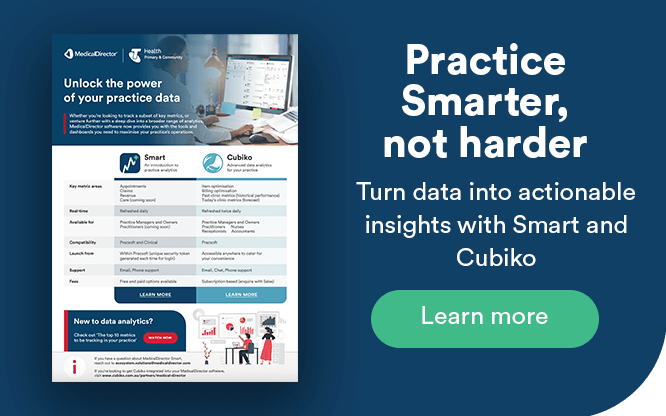Is it time to upgrade your healthcare software?
If your practice is using clinical software that’s slow and out-of-date, not only is this having an impact on your team’s productivity, your patients could be getting frustrated too. And with healthcare increasingly becoming digitised, could it be time to switch to a solution that offers more efficiency, flexibility and cost-savings? If you’re looking for ways to improve how your practice operates, here are some reasons to think seriously about upgrading your software.
You want to reduce IT costs
If your practice is still using traditional server-based clinical software, you might be well aware of how expensive it can be to maintain and upgrade. Using on-premise software that stores your patient information on a physical server in your practice can involve a number of high ongoing costs such as hardware, external IT support to assist with upgrades and technical issues, and a third-party data security solution if your software doesn’t include this.
The alternative is to switch to cloud software, which many practices have done in order to increase efficiency and flexibility. With cloud software, the only infrastructure you need is a computer and Internet access, making accessing and storing your information far more flexible and less costly.
Software updates and new functionality are incorporated by the software provider remotely, reducing maintenance and upgrade costs for the practice. These automatic updates help keep your software and data accurate, up-to-date and secure, with little effort or downtime required for the practice. That means you can spend more time caring for patients, and less time worrying about your software.
You want your practice to run more efficiently
Software that isn’t working as efficiently as it could can waste valuable time and be frustrating for both your team and patients. If your staff frequently complain about how long it takes to complete a task in a workflow, or the number of bugs or errors they encounter when using the software, then it could be time to upgrade.
If you have staff that are able to work remotely, for example, through visiting patients in their homes or conducting telehealth consultations, then cloud software is almost essential. If users don’t have to be located physically in the practice to access patient information, but instead, can access it from anywhere, then your staff can work far more efficiently, increasing the overall productivity of your practice.
You want to keep your data secure
Cyber security threats are a major issue for the healthcare industry as medical data is able to be bought and sold on the dark web by cyber criminals. A cyber security incident can be incredibly damaging to a practice, causing patients to lose trust in the practice’s ability to manage their sensitive information appropriately. If an eligible data breach has taken place, a practice could also receive a significant financial penalty.
If you use traditional server-based software, you might need to engage a third-party solution to manage data security for you. However, if you move to cloud-based software, your information will be kept secure as part of the technology. Data is stored remotely on the Internet in ‘the cloud’ and is backed up by dedicated data security centres. Any required updates to security are handled remotely by the software provider, removing the need for a practice to engage a third-party to keep data secure.
You want to improve your patients’ experience
Patient expectations have evolved, particularly since COVID-19 resulted in the digitisation of tasks in a short amount of time. Patients expect to be able to book appointments online, see instant replies to queries, receive invoices and receipts on email and get SMS appointment reminders. If you’re using out-of-date software that’s clunky and slow, or without the features that patients have come to expect, it could be difficult to remain competitive and see return visits.
Unlike traditional server-based software, cloud software can be easily integrated with the latest apps to provide you with additional functionality such as online booking, SMS reminders, more efficient billing and payment processes, and knowledge databases. As long as these apps are compliant with your clinical software (speak to your software provider about this), then they’re a great way for your practice to increase efficiencies and provide a better patient experience.
How much can you save?
Your clinical software represents a significant cost for your practice, especially if you need to engage third-party IT support to assist with ongoing maintenance and updates. If you’re considering upgrading your software to a cloud-based solution, you might be interested to find out exactly how much you could save.
To help you evaluate your budget and get an idea of how much you can save if you switch to MedicalDirector software, try our free calculator.
To learn more about MedicalDirector Helix cloud clinical software, check out our short micro-experience videos.










